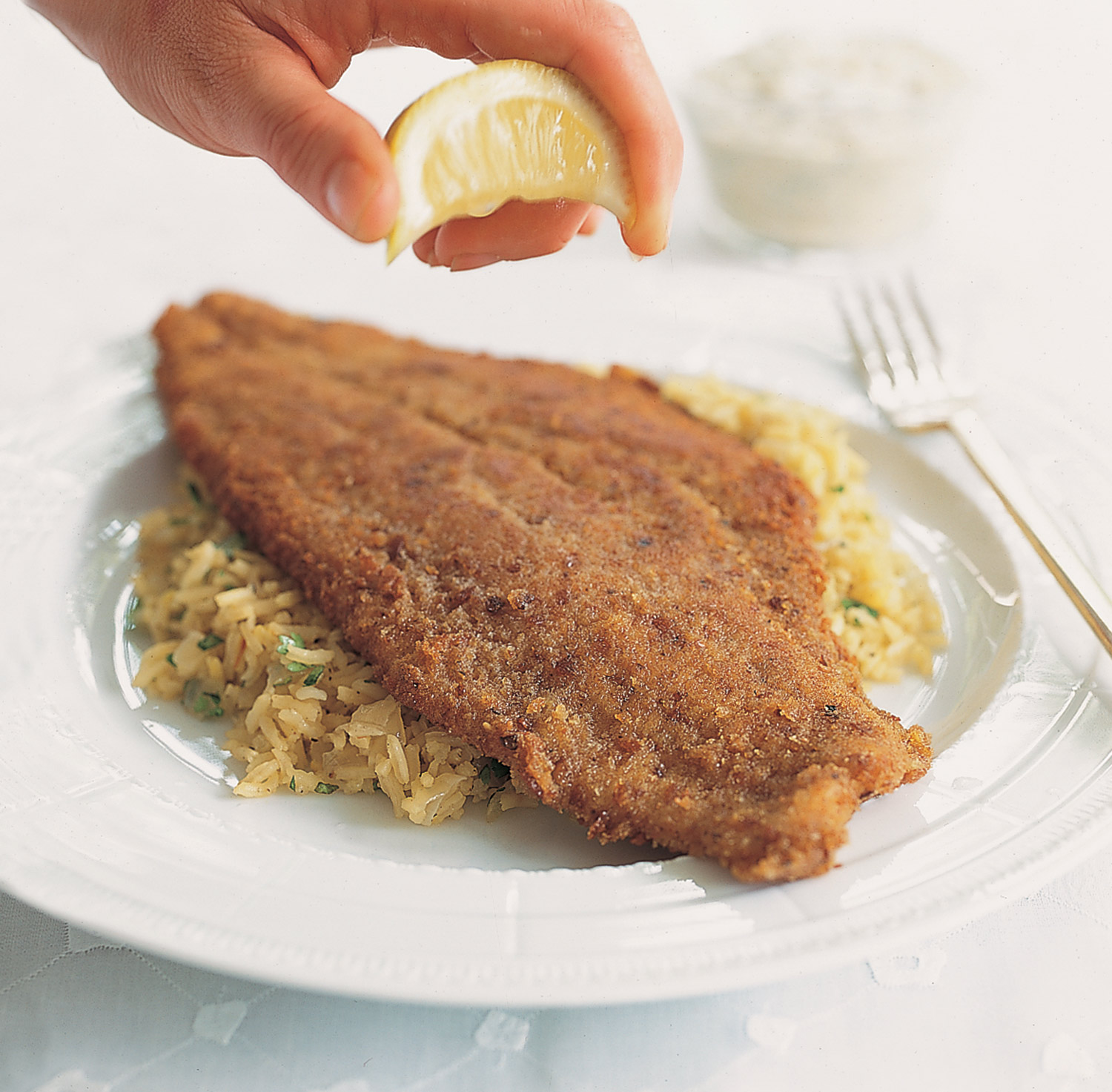
Any time I’ve suggested a tool, a piece of equipment, or a culinary term that’s unfamiliar to you, you can go to Learn to Cook for more information.
Put the flour on a shallow rectangular tray or baking sheet and season it lightly with salt and black pepper. Use a fork to beat the eggs in a 13 x 9-inch dish and, if desired, stir in the minced herbs and garlic. Place the eggs next to the tray of flour. Place the dried bread crumbs on another shallow rectangular tray and position this on the other side of the eggs. Line one or two more large shallow trays with wax paper. Rinse the fillets and dry them well. Sprinkle them lightly, on both sides, with salt and pepper.
Working with two fillets at a time, dredge (coat) each one, on both sides, in the seasoned flour and shake off the excess. Lay each fillet, side by side, in the beaten eggs, and then turn them over to coat both sides well. Lift both fillets out of the eggs and let any excess drip back into the dish. Lay the fish on top of the crumbs, and then turn them both, to coat the other side. Turn the fillets in the crumbs, several times, while using your working hand to press the crumbs gently onto both sides, until the fillets are heavily coated with crumbs. Lay the breaded fillets on the prepared trays. If using one tray, fill the tray then cover that layer with wax paper. Lay the remaining breaded fish on top. After each batch (2 fillets), rinse and dry your hands, before continuing. Cover the breaded fillets with plastic wrap and refrigerate, for at least an hour.
Use a rubber spatula to combine the mayonnaise, mustard, onions, pickles, capers, lemon juice, herbs and black pepper, to taste, in a bowl. Refrigerate the sauce, covered, until needed.
Place two large wire cooling racks close to the stove. Heat one or two 12 to 14-inch nonstick skillets over medium-high heat and, when hot, add enough vegetable oil to generously coat the bottom of the pan, to a depth of 1/4-inch. When the oil is just hot, add the flattened garlic, if using, and press on it with a heatproof utensil, as you allow it to brown and flavor the oil. Remove garlic (tastes great!) and, when the oil is nice and hot, but not smoking, add a tablespoon of butter to the pan, if desired, and let it sizzle and melt, without allowing it to color.
Add two breaded fish fillets to the hot fat, in a single layer, and fry them until golden brown and crisp on both sides, turning once, about 4 minutes per side (see below). Transfer each fillet directly to the wire rack and use paper towels to gently blot off any excess oil from the top. Continue to fry the remaining fish. If, at any time, the bottom of the pan accumulates too many over browned crumbs, dump out all the oil, wipe out the skillet and heat fresh oil, before frying the next batch. Serve the fish hot with the tartar sauce and lemon wedges.
The fish can be breaded one day ahead and kept refrigerated, covered with plastic wrap.
The tartar sauce can be made two days ahead and kept refrigerated, covered.
The fish can be fried up to 30 minutes before serving. To reheat, place the fillets, on their wire racks, on two shallow baking sheets and place the sheets into a preheated 375oF oven, on the upper and lower third shelves. Heat just until the fish is hot throughout, about 5 minutes, making sure not to overcook it.
To avoid getting inadvertently burned when turning a large fillet or cutlet, when pan-frying, it’s important to use the right type of turning spatulas. You’ll need two long (preferably perforated) metal spatulas, each with an elbow bend. I use metal, even when cooking in a nonstick pan, since these are the sturdiest of all the turning spatulas.
To turn food safely, after it’s browned on one side, use your working hand to insert one spatula under the food, at one end, going as far across the bottom as possible. Using your nonworking hand, lay the second spatula on top of the food, with the handle positioned on the opposite side. Lift the bottom spatula, holding the food, and carefully turn it over, using the second spatula to ease it back into the hot oil. Always bring the food as close as possible to the oil before releasing it, to prevent hot fat from splashing out.